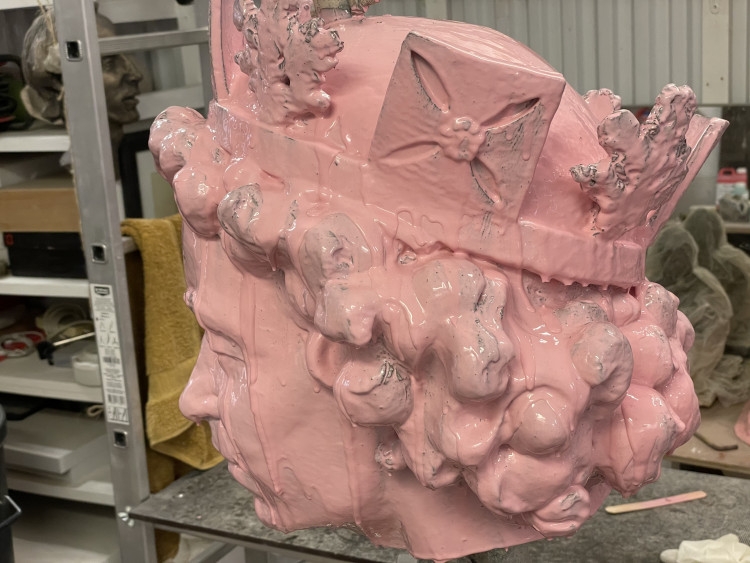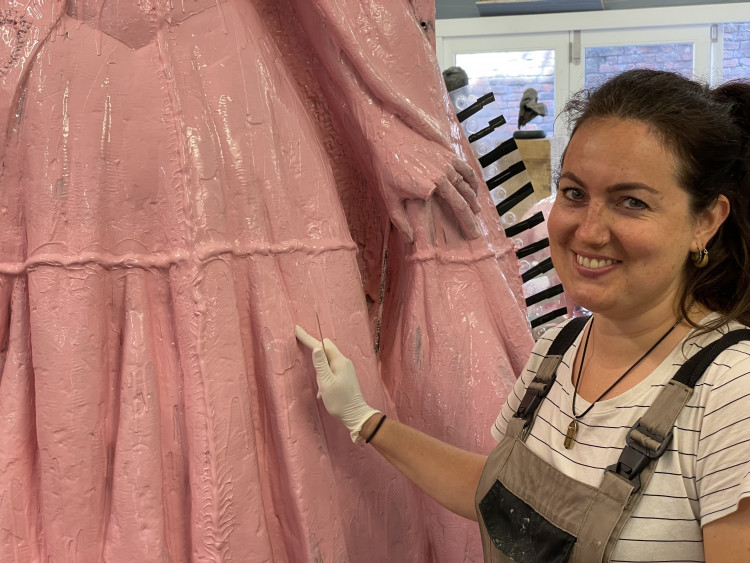Statue of late Queen reaches another milestone
By Evie Payne 15th Aug 2023
By Evie Payne 15th Aug 2023

A statue of the late Queen Elizabeth II, which will be unveiled later this year, has reached another stage in the process.
The statue of Queen Elizabeth II was commissioned by the Lord-Lieutenant of Rutland, Dr Sarah Furness, at a private Oakham Castle event and will be the country's first permanent memorial to the Queen.
Last month, Rutland County Council gave permission for the £125,000 statue, which will be funded almost completely with public subscription, to be sited at the back of the library in Oakham.
Work on the statue commenced last month, by sculptor Hywel Pratley.
Work continues on the statue by sculptor Hywel Pratley, who has now reached the 'silicone stage' of the process, and is being helped by Naomi Edwards of Edwards Moulding and Casting, based in Robertsbridge, East Sussex.
Following the completion of the clay modelling stage, the statue is covered in a thin layer of pink silicone rubber mixture, known as the 'detail layer', and while wet this then runs and is brushed, pushed and blown into every crevice and cavity so that an accurate mould is obtained.
"The pink is the colour of the catalyser which makes the silicone rubber set," Hywel said.
"Unfortunately, we've had to remove the Queen's head because when you are making a mould of this size you have to think about access at each stage in the process.
"This statue is just over 7ft tall, and to get to the head and the crown at height would be impossible to do without an accident. So the idea is to divide the entire statue into manageable pieces on which we can then work as we move to the wax casting stage after this."
The statue is being created using what is known as the 'lost wax' process of metal casting. Molten metal – in this case bronze – will eventually be poured into a mould which is created from the clay form.
The silicone rubber is part of that mould-making process, with the pink mixture poured all over the statue building up as many as four layers, one after another, with each successive pour thicker than the last, eventually producing a 5mm to 7mm thick, malleable, but exact copy of the clay model beneath.

"For ease of access, and also to make the mould lighter, we've had to design these 'divisions' in the mould," Hywel said.
"We've taken the head off, and closer inspection shows that we've also cut two fingers off because these areas are so intricate, delicate and complicated, we need to give them separate attention."
Naomi Edwards, who has worked with Hywel Pratley on a number of projects, said the body of the statue will also need to be divided into manageable sections.
"We form what is known as a 'silicone bead' using a standard cookery piping bag. These beads then act as the division lines when we come to cut the parts of the statue into separate pieces once the silicone is completely dry," she said.
The pink silicone mixture goes tacky within 15 minutes, after which it cannot be further manipulated, so both Hywel and Naomi use brushes, wooden sticks and even blow onto the rubber surface to ensure that it moves into every space on the clay, to capture the detail of the sculpture.

"I've inserted plastic location markers, known as 'shims', into the middle of the bead along the line of the cut," Naomi said, pointing to a bead that will eventually be a cutline on the robes of the Queen. "The shims are then taped together to create a mould division along which we will be making the cuts.
"Because of the sheer size of the statue, there will be four divisions on the front body of the Queen, and another four divisions at the back on the robes she is wearing, meaning that the main body of the statue will eventually end up in eight separate pieces."
The pink silicone, once set and then cut would flop all over the place if unsupported. So Hywel and Naomi will cover the rubber with several layers of fibreglass, up to 3mm thick, and these will then act as 'walls' supporting the structure.
The silicone layering process is expected to take until the end of this week, and the fibreglass layering over the top of the silicone is expected to take another week.
CHECK OUT OUR Jobs Section HERE!
oakham vacancies updated hourly!
Click here to see more: oakham jobs
Share:














